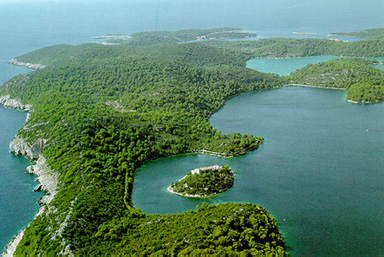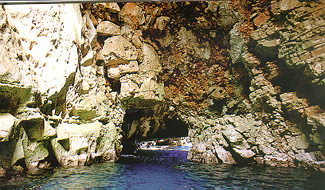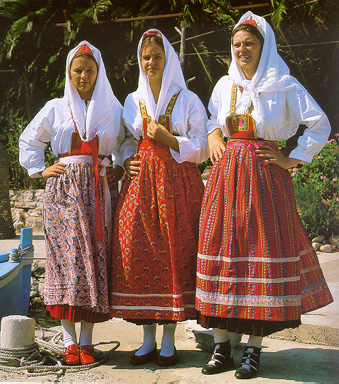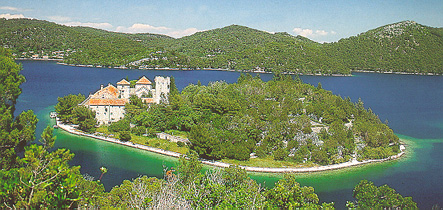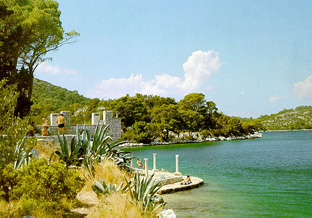|
|
ISLAND OF MLJETIs Island of Mljet Homer's Ogygia?Zvonko Springer,
Slazburg, Austria, 1999 We have visited the Island of Mljet in September 1997 and found an article titled "MLJET - Ulysses' Island of Ogygia" that roused my interests. The elongated Island of Mljet is almost parallel Peninsula of Peljesac across the Mljetski Channel of some 8 km width. Mljet is located not far away at West of the coastal city of Dubrovnik. Some have held Mljet to be Home's "Ogygia" where the beautiful goddess Calypso supposedly kept Odysseus as her lover for seven years during his traveling from the Trojan War to return home. There is a cave on Mljet below the village of Babino Polje that matches to some extent Homer's description of Calypso's lush cave, but then Mljet is hardly out "in the navel of the sea" as Homer described Ogygia to be. The story written by Mirjana Sanader found in the on-flight magazine of "Croatian Airlines" for Summer 1997 starts with the following citation:
" Round her cave there was a thick wood of alder, poplar, and sweet smelling cypress trees, wherein all kinds of great birds had built their nests - owls, hawks, and chattering sea crows that occupy their business in waters. A vine loaded with grapes trained and new luxuriantly about the mouth of the cave; there were also four running rills of water in channels cut pretty close together and turned hither and thither so as to irrigate the beds of violets and luscious herbage over which they flowed. " [Homer's Ulysses, Book V, 64-73]
Readers of these lines from the Odyssey have long tried to figure out which was the beautiful island Ogygia that was the home of the sea nymph Calypso. Few think that the poet was trying to celebrate in verse the beauties of Mljet that is one of the Adriatic Islands. We're talking about one of the episodes of Ulysses return to his native island of Ithaca, when, after a shipwreck, a 9 day long aimless wandering brought him to the island of Ogygia. The hero was enchanted with the beauty of the island as well as with the beautiful sea nymph Calypso, who fell in love with him. However, the idyll did not last long, for Ulysses soon became homesick. But he had to wait for seven long years, which he spent mainly sitting on the seaside, staring at the open sea. From this (sweet) slavery the heavenly messenger Hermes, who came to the island to deliver to Calypso Zeus's ultimatum that she must relinquish her hero, liberated him.
To this day no monuments have been found proving presence of Greece on island. However, it is absolutely certain that the ancient Greeks knew about Mljet because there exist ancient records dating back 4 centuries BC, in which this island is mentioned. Agesilaus of Anaxarba, who had been governor of Cilicia (now eastern Turkey), was banished to Mljet by the Roman Emperor Septimus Severus (AD 145-211) for some perceived slight. One of the legends - written sown some time in the 16th century - mentions that Mljet served as shelter to the Greek leader Agesilaus and his son Oppianos. Oppianos of Anaxarba is a historical personage who lived in the 2nd century and wrote some 5 volumes about fishing, the Halieutica, while on Mljet but there is no proof for that yet. This poem supposedly pleased Caracalla, son of Septimus Severus, that he awarded Oppianos a gold coin for each line (about 3500 of them) and permitted Oppianos and Agesilaus to return from exile. A local legend refers to a palace built by Agesilaus of Anazarba at Polace where still some ruins exist now-a-days. These ruins in fact are rather too late to have been built by Agesilaus, and it seems that they are the remains of an extravagant hunting lodge built by one Pierius in 489 AD, to whom Odoacer, king of Italy, had given Mljet in settlement of a debt. However, there is no dispute about that the fleet of Caesar Octavian attacked Mljet in 35 BC to subdue the pirates and to curtail their misdeeds there too. Emperor Octavian had to subjugate islands whose inhabitants were practicing intractable piracy that endangered the safety of Roman vessels. After defeating them militarily Octavian's wrath was terrible and he let killing the entire islands' population saving only the physically fit to be thrown into slavery. Thus the island of Mljet became an imperial property and the Roman colonists settled thereafter. They began cultivating grapes and growing olive on this fertile land, probably also the production of honey, as shown by the etymology of the island's name. That the agriculture was the island's most important factor proves also a Roman inscription saying that the god Liber was worshipped on the island and had a shrine there. Liber, a very ancient Italic deity, was used as the symbol of wine growing and agriculture in general. During Roman times the name MELITA (meaning the "Island of Honey") was used for both the islands that of Mljet and of Malta as well. One had also argued about St. Paul's shipwrecking in 62 AD that happened on Mljet and not on Malta but ended without any reasonable result. Much more is known about the history of Mljet from the time when the Romans were rulers in the Adriatic. Thus Appianos, the Roman historian, writing about the Illyrian wars, mentions the island of Mljet, as well as its Roman name, Melita. From description of St. Luke in the Acts of Apostles, chapters 27 and 28, we know that during St. Paul's journey from Caesarea to Rome there was a shipwreck on the island of Melita. At that time there were two islands on the Mediterranean bearing the name of Melita: today's Malta, and the island of Mljet not far from Dubrovnik. There are many arguments that the shipwreck occured on this island of Mljet, and not on Malta, see [Nicetic] (professor of the University of Dubrovnik, and experienced mariner). The journey from Crete to Malta would be impossible due to unfavorable winds and unfovarable sea currents. Archeological excavations on Mljet have pointed to existence of Early Christian basilica which according to local tradition belonged to the Church of St. Paul. There are also other archeological findings on Mljet bearing Christain symbols of Syrian and Palestinian origin, datin from 5th to 6th centuries. Ignjat Djurdjevic (Ignatio Georgio), a Dubrovnik baroque writer, poet, and historian, issued a book D. Paulus Apostolus in mari, quod nunc Venetus sinus dicitur, naufragus, et Melitae Dalmatensus insulae post naufragium hospes, Venice, 1730, with a map drawn by Giovanni Battista Tiepolo, kept in the Metropolitan Museum in New York, indicating that St. Paul had shipwreck in the Adriatic (Mare Adriaticum) on the island of Mljet (Melita). Added by D.Z., 2005. The most impressive antique monuments on the island are the remains of a former sumptuous building located in today's village Polace (pronounce "Polache") at northern island's shore that name is derived from this substantial palace (palazzo) from the Roman era. The palace was built on a mild decline as a residential, one floor, summer building, with two towers at its front whose stone walls reached down to the coast line. Today parts of 10+ m high walls and few vaults are found at the western village's entrance. One can also find some ruins of larger buildings next to the mentioned palace as well as smaller remnants of other dwellings, which show a larger populations at this port in ancient times. The aborigines of the island of Mljet were the Illyrians as based upon their sepulchral monuments and tombs. When the Croats settled on the Adriatic as from 8th century, the island was given to the people of Neretva Valley. They continued to live there side by side with Roman settlers, as reported by the Emperor Constantine Porphyrogennetos in the 10th century. In 1151 the island was donated by a Zahumlje nobleman to Benedictine monks, who built a monastery on the islet of the Veliko Jezero (Great Lake). This monastery was built in the Romanesque style, and some architectonic traces bear witness that on this beautiful spot there had been some dwellings even in ancient times. In the 16th century the monastery was refurbished in the Renaissance style, and so it stands until this day. Next to the monastery, on its western side, they built the church of St. Mary in the Romanesque style too that is still preserved despite some non congenial changes. Apart from St. Mary's, the island of Mljet has a number of other small churches, for instance the Church of the Holy Trinity, in the village of Prozure, where one can see a beautifully preserved Romanesque crucifix today .
GENERAL ABOUT THE ISLAND OF MLJET Mljet is located in the South Dalmatian cluster of islands, not far from Korcula and Dubrovnik. Its area covers about 1000 km2, and it counts about 700 only of it original 3500 inhabitants. The municipal center is at Babino Polje which is the largest village midway on island's ridge. Mljet is long but not wide some 37 km long and in average 3 km wide only. The island's geological structure consists of limestone and dolomite forming ridges, crests and slopes. The island's carbonate structure formed its relief and landscape characteristics, which are those of a karst terrain. There are no open dolines and in the lowest parts of "poljes" (fields) and karst holes atmospheric water disappears underground and flows to the sea. Some of these depressions are on or below sea level and between which reciprocal water flows takes place. These little depth lake's like depressions are known as "slatine" or "blatine" have fresh water between autumn and spring and turn to brackish one during dry seasons. The water level in all of four "blatines" varies constantly and sometimes dropping to zero and exposing the "eye" or sinkhole. There are two existing lakes were created by tectonic movements forming deeper depressions that subsequently filled with water.
The central part of Mljet is a highland with three parallel ranges with the highest point Veliki Grand is 514 m asl. The western and eastern thirds of the island are somewhat lower but the highland features of relief and landscape are present there too. The large loess deposits at eastern part are of geological interest and form the hind part of the beautiful bays Saptunara and Blaca. This area is still undeveloped because a naval base there has closed recently only. Mljet is the most heavily wooded island in the Adriatic: its hills are green year round with Evergreen Holm Oak, Flowering Ash, Aleppo pines and Carob tree. The beauty of the island lies not only in dense pine forests only as also in the clear sea which completely surrounds it and the two salt-water lakes in its interior. The western end of the island of some 31 km2 was set aside as Mljet National Park in 1960, and this park centers around two marine lakes: Veliko Jezero (Big Lake) and Malo Jezero (Small Lake). When sea levels were slightly lower, these lakes were true lakes and a small channel 2,6 m wide and 50 cm deep joins Malo Jezero to Veliko Jezero. It is bridged over for a path continuing round the entire perimeter of Veliko Jezero. Veliko Jezero is linked to the sea of Soline Bay by another channel originally 4 m wide and 50 cm deep. The old arched bridge over it was destroyed when this channel had been deepened in the 1960s providing the access for larger yachts into Veliko Jezero. The inflow of fresh sea water over shallow threshold in these channels is rather small. Therefore, there are significant differences in salinity and temperature as well as in plant and animal life in the lakes compared to the ones outside bays. A special barrier has been built in 1997 to prevent any ecologically destructible influences from the open seas. There are several larger settlements on the island, such as
Govedjari, Babino Polje and Korita. The emigrating Sephardic Jews from
Spain settled in the village of Maranovici. Now, one still meets people
with different features compared to those ones of dominant Croatian
population. The islanders, apart from being very good hosts to
tourists, have been busy from times immemorial with producing olive
oil, as well as wine and honey. The island has always been an example
of man's respect towards nature and their mutual relationship. It was
exactly because of this that, in 1960, Mljet was proclaimed a National
Park. Thanks to the strict observance of rules regarding the upkeep of
natural and cultural heritage, the unique beauty of this island has
been preserved. Thus, Mljet is considered with good reason to be the
most beautiful amongst of the numerous Croatian island. ISLAND OF SAINT MARY
There is one only larger hotel at Pomena village at far westward part of Mljet within the National Park itself. From there one has to transverse a small ridge of some 125 steps up and down to reach Malo Jezero. After say 10 minutes more of walk one reaches to Mali Most (Small bridge). National Park service provides regular boat transit in Veliko Jezero, which takes visitors to the island named Sveta Marija ("ISLAND OF ST. MARY"). St. Mary's island has had a remarkable history and influence. The Neretvyan Prince Desa of Zahumlje and Diocleia (Dalmatian coastal kingdoms) granted the islet of the Great Lake (Veliko jezero) to the Benedictine monks in 1151 who built a monastery there. The Benedictines monks came to Islands of the Adriatic (like to Island of Vis) from the Monastery of Saint Mary in Pulsano, Italy. The monks named this islet for St. Mary and the attached church of the Assumption of the Virgine. Both buildings were constructed in the Romanesque style in an able bodied form providing refuge for villagers against piracy or aggression. There are some architectonic traces bearing witness that on this spot had been some dwellings even in ancient times. Later, the monastery was expanded and rebuilt particularly during the time of the Dubrovnik Republic, which ruled Mljet from 1345 till 1808. In the 16th century the monastery was refurbished in the Renaissance style as it stands today.
The monastery authorities allowed settlers on their lands only when their need for labor became pressing, so they leased plots to farmers or even gave to them in return for their obligation to work their land and tend their animals. Thus, the monastery's cattle herdsmen founded the first village "Govedjari" (from "goveda" = cattle), on the edge of Pomijenta plateau. To protect the very picturesque and characteristic architecture of the village, Govedjari got the status of an ethnological zone within the National Park. First the western part of the island was settled and held all the key functions until the 12th century. The present villages in that part are all much more recent settlements, from the late eighteenth century onwards. The reason is that the monastery was the feudal owner of the whole island at first. Later the Dubrovnik Republic restricted its domain to the western part of the island only. Until the end of the 18th century, the monastery authorities allowed no permanent settlements in that area which explains why the forests are so well preserved in what is now the National Park . A total of 354 people in 89 households live in the National Park (1985) now. The population in the park area is not declining in contradiction to the rest of the island. This due to the attractiveness of the National Park and the opportunities it offers for tourist development, like "Odysseus Hotel" at Pomena, as well as some private accommodations, excursion, visits, etc. It's more pleasant to swim in both lakes and at St. Mary's island too as water's temperatures are 4-8 C° above of sea's one.
The importance of the monastery is not only architectural. For full six centuries it served as a focal point of culture, radiating cultural influences far afield. Many learned men and poets lived in the monastery as monks or abbots: Mavro Vetranovic Cavcic Mavro Orbini, Bazilije Gradic, Euzebije Kaboga, Anselmo Banduri, Ignjat Djurdjevic, and others. Many verse compositions, learned treatises and chronicles, documents of Croatian history and culture, were written in the idyllic setting of the Mljet forests and lakes. Holiday makers now use the rooms occupied by the monks in earlier times, which was one way of saving the precious historic building from ruin. Unfortunately, under Tito's regime the monastery was turned into the "Hotel Melita" to be used for recreation of workers from a state company in Belgrade. Following the Home War "Hotel Melita" was closed for good in 1995 . The National Park Authorities are in charge of its historic monuments at last. The monastery's paintings are in museums in Dubrovnik but interiors of both the church and the monastery were very badly damaged. Many years will pass before the repairs, which started late in 1997, will be completed. The rose bushes and lemon trees of the monastery garden were overgrown with weeds and the garden's clearing has started in fall 1997 too. Sources: - Bralic, Ivo, The National Parks of Croatia, Zagreb; Skolska
knjiga 1990. DISCLAIMER : On URL: http://www.cosy.sbg.ac.at/~zzspri/ published pages are originals and authorized by copyright of Zvonko Z. Springer, Salzburg 1999. Email Zvonko Springer at : zzspri@aon.at St Paul the apostle spent three months on the island of Mljet in Croatia St. Paul's shipwreck in 61 AD that happened on the island of Mljet, and not on Malta Croatia - its History, Culture and Science
|
